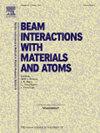Advances in dynamic and batch processing of PIXE spectra
IF 1.4
3区 物理与天体物理
Q3 INSTRUMENTS & INSTRUMENTATION
Nuclear Instruments & Methods in Physics Research Section B-beam Interactions With Materials and Atoms
Pub Date : 2025-05-13
DOI:10.1016/j.nimb.2025.165734
引用次数: 0
Abstract
We present here the advances on two custom-built software programs for PIXE spectra processing, both of them based on the GUPIX package. The first one, named LivePIXE, is a standalone executable that has been implemented in the New AGLAE data acquisition system to process dynamically PIXE spectra during recording, almost in real-time. It allows to verify if the selected area of the object is relevant for the analysis and it provides a first interpretation of the PIXE results in order to orientate further analysis. The second program presented here is an updated version of the TrauPIXE software, which we had previously developed to process series of recorded PIXE spectra. As different X-ray absorbers can be installed in front of the detectors, each element of interest in the sample can be measured with different detection limits and uncertainties. This updated version selects the most precise element concentrations from all the PIXE results. It can also take into account the elemental concentrations obtained simultaneously by PIGE or/and RBS and incorporate them during the PIXE processing and into the final compositional table.
PIXE光谱动态和批量处理研究进展
本文介绍了两个基于GUPIX软件包的PIXE光谱处理定制软件程序的进展。第一个软件名为LivePIXE,是一个独立的可执行程序,已在New AGLAE数据采集系统中实现,可以在记录过程中几乎实时地动态处理PIXE光谱。它允许验证对象的选定区域是否与分析相关,并提供对PIXE结果的第一次解释,以确定进一步分析的方向。本文介绍的第二个程序是TrauPIXE软件的更新版本,该软件是我们之前开发的,用于处理一系列记录的PIXE光谱。由于不同的x射线吸收器可以安装在探测器的前面,样品中的每个感兴趣的元素可以测量不同的检测限和不确定度。这个更新的版本选择最精确的元素浓度从所有的PIXE结果。它还可以考虑PIGE或/和RBS同时获得的元素浓度,并在PIXE处理过程中将其纳入最终的成分表中。
本文章由计算机程序翻译,如有差异,请以英文原文为准。
求助全文
约1分钟内获得全文
求助全文
来源期刊
CiteScore
2.80
自引率
7.70%
发文量
231
审稿时长
1.9 months
期刊介绍:
Section B of Nuclear Instruments and Methods in Physics Research covers all aspects of the interaction of energetic beams with atoms, molecules and aggregate forms of matter. This includes ion beam analysis and ion beam modification of materials as well as basic data of importance for these studies. Topics of general interest include: atomic collisions in solids, particle channelling, all aspects of collision cascades, the modification of materials by energetic beams, ion implantation, irradiation - induced changes in materials, the physics and chemistry of beam interactions and the analysis of materials by all forms of energetic radiation. Modification by ion, laser and electron beams for the study of electronic materials, metals, ceramics, insulators, polymers and other important and new materials systems are included. Related studies, such as the application of ion beam analysis to biological, archaeological and geological samples as well as applications to solve problems in planetary science are also welcome. Energetic beams of interest include atomic and molecular ions, neutrons, positrons and muons, plasmas directed at surfaces, electron and photon beams, including laser treated surfaces and studies of solids by photon radiation from rotating anodes, synchrotrons, etc. In addition, the interaction between various forms of radiation and radiation-induced deposition processes are relevant.

 求助内容:
求助内容: 应助结果提醒方式:
应助结果提醒方式:


